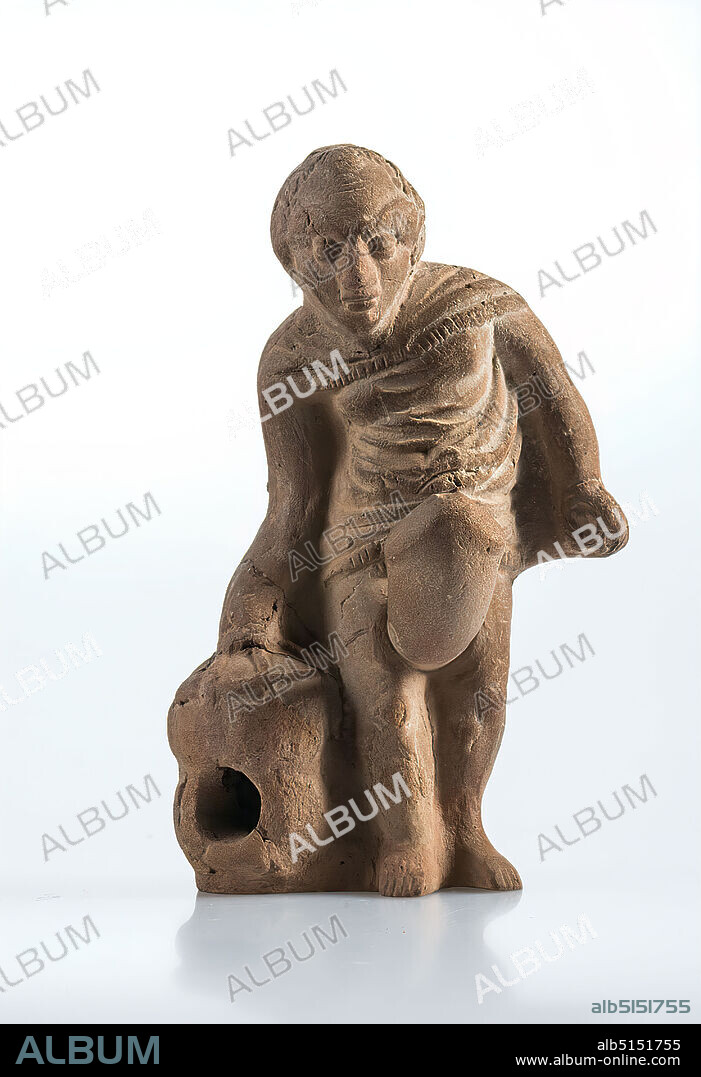alb5151755
Ithyphallic slave with lantern, formerly Slg. Friedrich Gütte (Hamburg), clay, Total: Height: 12.9 cm; Width: 9 cm; Depth: 8.5 cm, ceramic, man, Hellenism, Early Imperial Period, Middle Imperial Period, Late Imperial Period, With bent back the stocky man stands on the right inclined to a lantern with closed legs from which an oversized phallus protrudes. The receding hair and the thin hair, as well as the bushy eyebrows and the thick, curved nose are deliberately ugly and are intended to evoke disgust. The erect limb dominates the figure and is decisive for its use. On the back is a device for hanging the grotesque. It is intended to draw the evil upon itself and thus protect the owner from harm. The figure belongs to the group of so-called Fayum terracottas. In Alexandria, the international, Greek-influenced center of Egypt, lives a multicultural society of Egyptians, Orientals, Greeks, Romans, Jews and others, whose different religious ideas are gradually blending together. Insights into this world of faith are provided by the so-called Fayum terracottas. They are part of the religious household, children's toys, knick-knacks, but also cult symbols, grave goods, pilgrimage images, votive offerings and magical objects for banishing evil forces. They can be found in houses, graves and sanctuaries.

|
Zu einem anderen Lightbox hinzufügen |
|
Zu einem anderen Lightbox hinzufügen |



Haben Sie bereits ein Konto? Anmelden
Sie haben kein Konto? Registrieren
Dieses Bild kaufen

Untertitel:
Siehe automatische Übersetzung
Ithyphallic slave with lantern, formerly Slg. Friedrich Gütte (Hamburg), clay, Total: Height: 12.9 cm; Width: 9 cm; Depth: 8.5 cm, ceramic, man, Hellenism, Early Imperial Period, Middle Imperial Period, Late Imperial Period, With bent back the stocky man stands on the right inclined to a lantern with closed legs from which an oversized phallus protrudes. The receding hair and the thin hair, as well as the bushy eyebrows and the thick, curved nose are deliberately ugly and are intended to evoke disgust. The erect limb dominates the figure and is decisive for its use. On the back is a device for hanging the grotesque. It is intended to draw the evil upon itself and thus protect the owner from harm. The figure belongs to the group of so-called Fayum terracottas. In Alexandria, the international, Greek-influenced center of Egypt, lives a multicultural society of Egyptians, Orientals, Greeks, Romans, Jews and others, whose different religious ideas are gradually blending together. Insights into this world of faith are provided by the so-called Fayum terracottas. They are part of the religious household, children's toys, knick-knacks, but also cult symbols, grave goods, pilgrimage images, votive offerings and magical objects for banishing evil forces. They can be found in houses, graves and sanctuaries.
Persönlichkeiten:
Bildnachweis:
Album / quintlox
Freigaben (Releases):
Model: Nein - Eigentum: Nein
Rechtefragen?
Rechtefragen?
Bildgröße:
2959 x 4320 px | 36.6 MB
Druckgröße:
25.1 x 36.6 cm | 9.9 x 14.4 in (300 dpi)
 Pinterest
Pinterest Twitter
Twitter Facebook
Facebook Link kopieren
Link kopieren Email
Email
